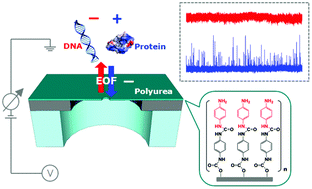Translocation of DNA and protein through a sequentially polymerized polyurea nanopore†
Abstract
Here, we investigated the translocation of biomolecules, such as DNA and protein, through a sequentially polymerized polyurea nanopore, with a thin (<10 nm) polymer membrane of uniform thickness. The polyurea membrane was synthesized by molecular layer deposition using p-phenylenediisocyanate (PDI) and p-phenylenediamine (PDA) as sequential precursors. The membrane exhibited a hydrophobic surface with a highly negative surface charge density (−51 mC m−2 at pH 8). It was particularly noted that the high surface charge density of the membrane resulted in a highly developed electro-osmotic flow which, in turn, strongly influenced the capture probability of biomolecules, depending on the balance between the electro-osmotic and electrophoretic forces. For instance, the capture frequency of negatively charged DNA was demonstrated to be quite low, since these two forces more or less cancelled each other, whereas that of positively charged MDM2 was much higher, since these two forces were additive. We also identified that the mean translocation time of MDM2 through the polyurea nanopore was 26.1 ± 3.7 μs while that of the SiN nanopore was 14.2 ± 2.0 μs, hence suggesting that the enhanced electrostatic interaction between positively charged MDM2 and the negatively charged pore surface affects the translocation speed.



 Please wait while we load your content...
Please wait while we load your content...